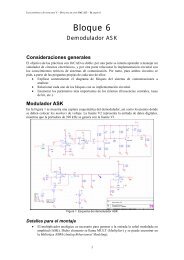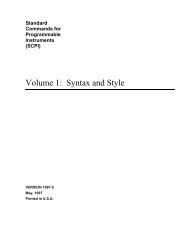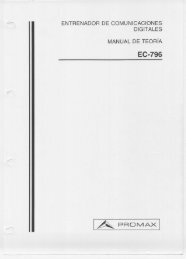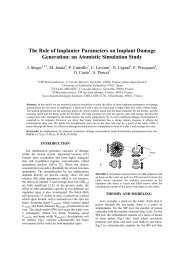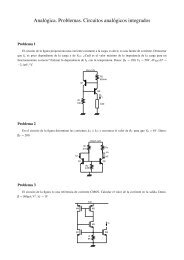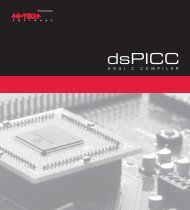High Power White LED Technology for Solid State Lighting Paul S ...
High Power White LED Technology for Solid State Lighting Paul S ...
High Power White LED Technology for Solid State Lighting Paul S ...
- No tags were found...
Create successful ePaper yourself
Turn your PDF publications into a flip-book with our unique Google optimized e-Paper software.
<strong>High</strong> <strong>Power</strong> <strong>White</strong> <strong>LED</strong> <strong>Technology</strong><strong>for</strong> <strong>Solid</strong> <strong>State</strong> <strong>Lighting</strong><strong>Paul</strong> S. MartinJ. Bhat, , C.-H. Chen, D. Collins, W. Goetz, R. Khare, , A. Kim, M. Krames, , C.Lowery, M. Ludowise, , G. Mueller, R. Mueller-Mach, Mach, S. Rudaz, , D. Steigerwald,S. Stockman, S. Subramanya, , S-C S C Tan, J. Thompson, T. Trottier1 Copyright (c) Lumileds <strong>Lighting</strong> LLC Company Confidential
<strong>High</strong> <strong>Power</strong> <strong>White</strong> <strong>LED</strong>sWho is Lumileds• Fully integrated light source supplier that co-develops optimized system solutions!• <strong>LED</strong> dice• Luxeon<strong>Power</strong> Light Sources• Arrays of <strong>High</strong> Flux <strong>LED</strong>s ona metal core PCB• Automotive, Traffic Signals, Signage & Contour Solutions2 Copyright (c) Lumileds <strong>Lighting</strong> LLC Company
<strong>High</strong> <strong>Power</strong> <strong>White</strong> <strong>LED</strong>sOutline• Competition in the market <strong>for</strong> Illumination, Incandescent & Fluorescent Bulbs.• <strong>LED</strong> Metrics• Options <strong>for</strong> making white light from <strong>LED</strong>s• Lumileds power white <strong>LED</strong> per<strong>for</strong>mance• Some interesting demos3 Copyright (c) Lumileds <strong>Lighting</strong> LLC Company
Illumination MarketsHow Much Energy is Used <strong>for</strong> <strong>Lighting</strong>• In 1999 the US used 3 Trillion kWhr of Electricity!• 20% or 600 Billion kWhr of Electicity generated was used in <strong>Lighting</strong>!• Incandescent/Hal. lamps burn 40% of electricity to produce 15% of light!• Fluorescent/HID lamps use 60% to produce 85% of light!• Illumination market is $60Billion/yr and growing slowly, ~2%/yr4 Copyright (c) Lumileds <strong>Lighting</strong> LLC Company
Illumination MarketsIncandescent Bulbs• Incandescent = hot light, emitted from a (tungsten) filament at around 2800 o K• Disadvantages:• mostly infra-redred• glass vacuum envelope & filament both break easily•
Illumination MarketsFluorescent Bulbs• Fluorescent = cold light, emitted by phosphors excited by gas discharge.• Advantages:• <strong>High</strong> efficiency 80+lm/W & <strong>High</strong> Flux klm/lamp• Moderate cost <strong>for</strong> large lamps 0.002$/lm• Disadvantages:• Lifetime short
Illumination MarketsAssumptions <strong>for</strong> using <strong>LED</strong>s in lighting• <strong>LED</strong> lamps will be far more expensive than incandescent, halogen orfluorescent lamps <strong>for</strong> at least a decade.• The expensive <strong>LED</strong> lamp must pay <strong>for</strong> itself through lifetime energy andmaintenance savings.• The lighting industry has spoiled the users with superb color rendering andcolor control.• Near term <strong>LED</strong>s must dominate monochrome and penetrate white niches!7 Copyright (c) Lumileds <strong>Lighting</strong> LLC Company
<strong>High</strong> <strong>Power</strong> <strong>White</strong> <strong>LED</strong>sOutline• Competition in the market <strong>for</strong> Illumination, Incandescent & Fluorescent Bulbs.• <strong>LED</strong> <strong>Technology</strong> & metrics• Options <strong>for</strong> making white light from <strong>LED</strong>s• Lumileds power white <strong>LED</strong> per<strong>for</strong>mance• Some interesting demos8 Copyright (c) Lumileds <strong>Lighting</strong> LLC Company
<strong>LED</strong> MetricsTower of Babble?optical power out / electric power in = Wall-Plug-Efficiency, WPE, (%,W/W)photons out / electrons in = External Quantum Efficiency, EQE, %photons internally generated / electrons in = Internal Quantum Efficiency , IQE, %photons out / photons generated = extraction efficiency, %, h extphoton energy / applied voltage (times electron charge) = electrical efficiency, %, h ellumens out / electric power in = luminous efficiency [lm/W]luminous efficacy, LE [lm/W] = luminous equivalent of the emission spectrumluminous efficiency = IQE*η ext*η el*LEIQE*η ext= EQEEQE*η el= WPEWPE*LE = lm/W9 Copyright (c) Lumileds <strong>Lighting</strong> LLC Company
<strong>LED</strong> Metrics<strong>LED</strong> Skulduggery<strong>Paul</strong>’s Top 5 Sins1) Quoting EQE without Vf or WPE2) Quoting low duty factor results3) Quoting WPE without current orcurrent density & total power out.4) Quoting WPE without temperature5) Quoting Cd without FluxWhat am I hiding?1) Vf, power efficiency2) Thermal resistance, heating3) GaN in particular has strongdependence of WPE on currentnot much light comes out of adevice at very low currents!4) WPE is strongly dependent onjunction temperature <strong>for</strong>AlInGaP, less so <strong>for</strong> AlInGaN.5) Radiation pattern10 Copyright (c) Lumileds <strong>Lighting</strong> LLC Company10
<strong>LED</strong> MetricsTower of Babble take 2 <strong>for</strong> white <strong>LED</strong>sHow well can a source reproduce “natural” colors = Color-Rendering-Index, Ra, %(100 = sunlight, 85 = office, 60 = cabinet/lantern light)Color Correlated Temperature = CCT, Kelvin(x,y coordinates normal to black body curve)Phosphor Converted <strong>LED</strong> = PC<strong>LED</strong><strong>LED</strong> photons pump phosphor which emits secondary,and longer, wavelength of light.Stoke’s shift = Difference in wavelength betweenabsorbed and emitted photons. Emitted photonsalways have longer wavelength, i.e. lowerenergy!0.90.80.70.60.50.40.310,000K2500K3300K5000KCIE1931Planckian locustungsten, 2850Khalogen, 3100Kdaylight, 6500K0.20.10.00.0 0.1 0.2 0.3 0.4 0.5 0.6 0.7 0.811 Copyright (c) Lumileds <strong>Lighting</strong> LLC Company11
<strong>High</strong> <strong>Power</strong> <strong>White</strong> <strong>LED</strong>sOutline• Competition in the market <strong>for</strong> Illumination, Incandescent & Fluorescent Bulbs.• <strong>LED</strong> <strong>Technology</strong> & metrics• Options <strong>for</strong> making white light from <strong>LED</strong>s• Lumileds power white <strong>LED</strong> per<strong>for</strong>mance• Some interesting demos12 Copyright (c) Lumileds <strong>Lighting</strong> LLC Company12
<strong>White</strong> Light from <strong>LED</strong>sThree methods of Generating <strong>LED</strong> <strong>White</strong> Light• Each method has potential strengths!Red + Green + Blue <strong>LED</strong>sUV <strong>LED</strong> + RGB PhosphorBinary ComplimentaryBlue PeakGreen PeakRed PeakUV <strong>LED</strong>SpectrumCombinedSpectrumPhosphorEmissionPhosphorEmissionCombinedSpectrumBlue <strong>LED</strong>Spectrum470 525 590 630 (nm)410 470 525 590 630 (nm)470 525 590 630 (nm)RGB <strong>LED</strong>sUV <strong>LED</strong> + RGB phosphorBlue <strong>LED</strong>+Yellow phosphor13 Copyright (c) Lumileds <strong>Lighting</strong> LLC Company13
<strong>White</strong> Light from <strong>LED</strong>sCombining Red, Green and Blue <strong>LED</strong>s• Advantages:• Long term likely the most efficient!• Dynamic tuning of color temperature possible!• Excellent color rendering!• Very large color Gamut available!• Challenges• Color Feedback required today to account <strong>for</strong> <strong>LED</strong> degradation with h T & t!• Color mixing tricky!• Yellow-Green Gap!<strong>LED</strong>CCFLNTSCEBU14 Copyright (c) Lumileds <strong>Lighting</strong> LLC Company14
Combining Red, Green and Blue <strong>LED</strong>sLumileds LCD Backlight!• 20 Green, 10 Red, 10 Blue Luxeon’s, , ~ 1000 lumens!• Today <strong>LED</strong> Solution has 140% Color Gamut and 120% CCFL power!Both displays showingthe same slide(red only background)via a splitterCCFL solution<strong>LED</strong> solution15 Copyright (c) Lumileds <strong>Lighting</strong> LLC Company15
<strong>White</strong> from RGB <strong>LED</strong>sThe Yellow-Green Gap!• Eye Sensitivity Peaks right in the middle of the Yellow-Green GaP!6050Tj = 25ºC<strong>LED</strong>sVCSEL40Conversion3020Best LaboratoryResultProductionAverage100450 470 490 510 530 550 570 590 610 630 650 85016 Copyright (c) Lumileds <strong>Lighting</strong> LLC Company16Wavelength (nm)
<strong>White</strong> Light from <strong>LED</strong>sUV <strong>LED</strong> pumped RGB Phosphors• Advantages:• <strong>White</strong> point determined by phosphors ONLY! (i.e. tolerant to <strong>LED</strong> variation)• Excellent color rendering possible!• Theoretically “Simple to manufacture!” (Looks like TV or Fluorescent lamp except<strong>for</strong> pump is now UV <strong>LED</strong> rather than electrons.)• Temperature stability of phosphors. (Can be great!)• Disadvantages• Potential <strong>for</strong> damaging UV light leakage.• Fundamental limits on efficiency due to phosphor conversion efficiency, Stokesshift, self absorption,…• Challenges• None available yet!?• Efficient Blue <strong>LED</strong> pumped phosphor not available yet?!• Color uni<strong>for</strong>mity with angle!• Packaging must be robust to UV exposure.• Temperature stability of phosphors. (Great phosphors not available le in all colors!)17 Copyright (c) Lumileds <strong>Lighting</strong> LLC Company17
UV <strong>LED</strong> pumped RGB PhosphorsUV <strong>LED</strong> must be >2x Green <strong>LED</strong> WPE <strong>for</strong> same lm/W!• Downshift in color causes fundamental energy loss.• Scattering in phosphor + absorption in package (inc. phosphor) reduces rextractionefficiency! Today’s best package efficiency is ~50% <strong>for</strong> Blue + Yellow phosphor,UV + RGB phosphor likely to be even worse!<strong>Power</strong> Conversion (%)100%90%80%70%60%50%40%30%20%10%0%Assuming 50% pkg. Efficiency!370 380 390 400 410 420 430UV Pump Wavelength (nm)Red 630nmBlue 460nmGreen 540nm<strong>White</strong><strong>White</strong> + Pkg18 Copyright (c) Lumileds <strong>Lighting</strong> LLC Company18
<strong>White</strong> Light from <strong>LED</strong>s<strong>White</strong> from Blue <strong>LED</strong> + Phosphor(s)• Advantages:• Simple and single Yellow phosphor versions available today!• Decent color rendering (Ra = 75 <strong>for</strong> Blue <strong>LED</strong> + Yellow Phosphor)• Temperature stability of phosphors. (Can be great!)• Disadvantages• Limits on efficiency due to phosphor conversion efficiency, Stokes shift, selfabsorption,…• Better color rendering (i.e. multi phosphor comes at cost of efficiency)• Challenges• Temperature stability of phosphors. (Great phosphors not available le in all colors)• Color uni<strong>for</strong>mity vs. angle• Multi phosphor versions to improve color rendering19 Copyright (c) Lumileds <strong>Lighting</strong> LLC Company19
<strong>White</strong> from Blue <strong>LED</strong> + Phosphor(s)Today, PC <strong>LED</strong>s are in the 20-30lm/W range!• Todays white <strong>LED</strong>s are in the ~20-30lm/W range!0.90.8<strong>LED</strong>, T = 25C<strong>LED</strong>,T = 105CYAG:CeCe 3+ doped garnet family,e.g.(Y,Gd) 3 Al 5 O 120.70.6520510530540Planckian locusCIE1931Combined with the same <strong>LED</strong>, Ce 3+phosphors hit the Planckian at differentcolor temperatures:0.50.40.30.20.1500490480470460450 nm10,000K5000K3300K2500K5906006206300.00.0 0.1 0.2 0.3 0.4 0.5 0.6 0.7 0.8640706050403020100CCT=4000K, Ra=75400 500 600 700 800 nmRa = 75 is not great (good FL has 83)but it is OK <strong>for</strong> some applications.20 Copyright (c) Lumileds <strong>Lighting</strong> LLC Company20
<strong>White</strong> from Blue <strong>LED</strong> + Phosphor(s)Color Uni<strong>for</strong>mity can be good <strong>for</strong> PC <strong>White</strong>!• CCT uni<strong>for</strong>mity of 50-100K is sufficient <strong>for</strong> high quality illumination.CCT (K)5400520050004800460044004200400038003600340032003000800K80K-85 -75 -65 -55 -45 -35 -25 -15 -5 5 15 25 35 45 55 65 75 85Theta (degrees)21 Copyright (c) Lumileds <strong>Lighting</strong> LLC Company21
<strong>White</strong> from Blue <strong>LED</strong> + Phosphor(s)Progress on Temperature stability of Phosphorsmeasured on powders(Y,Gd)AG:Ce120000025 CI(T)/I(25C), %10080604020(Y,Gd)AG, 4 mol% Ce[Gd]0%255075radiance under 460 nm excitation5010000001001208000001506000002004000002000000400 450 500 550 600 650 700 750 800nm025 50 75 100 125 150Temperature, Cnovel phosphors with improvedcolor specs emerge; in this caseusing a Ce 3+ - Pr 3+ transfer ofexcitation energy and yieldingmore temperature stable behavior1200000251000000800000501001206000001502004000002000000400 500 600 700 80022 Copyright (c) Lumileds <strong>Lighting</strong> LLC Company22
<strong>White</strong> from Blue <strong>LED</strong> + Phosphor(s)The 2-phosphor2phosphor-converted <strong>LED</strong> – 2pc<strong>LED</strong>0.90.80.70.60.51 <strong>LED</strong> + 2 phosphors530TG:Eu5205405102.001.501.000.50820671937118combospecRa = 920.00400 500 600 700 800HP <strong>LED</strong>, T = 25CHP <strong>LED</strong>,T = 105CPlanckian locusPhosphorsCIE1931Series15Adding green and red to theblue of the <strong>LED</strong> opens a hugecolor gamut and allows <strong>for</strong>de-luxe white of any colortemperature – our best choice• SrGa 2 S 4 :Eu 2+ - green• SrS:Eu 2+ - red0.40.350049010,000K2500K3300K5000K590600SrS:Eu610620630combospec0.21.601.40Ra = 924801.201.000.800.10.604700.400.204600.00400 500 600 700 8000.00.0 0.1 0.2 0.3 0.4 0.5 0.6 0.7 0.8640The dipole-allowed 5d-4ftransitions of Ce 3+ and Eu 2+are uniquely suited <strong>for</strong> colorconverters:high absorption, smallStoke’s shift23 Copyright (c) Lumileds <strong>Lighting</strong> LLC Company23
<strong>White</strong> Light from <strong>LED</strong>sAll three white <strong>LED</strong> technologies share Threechallenges!1 Maximize efficiency in lm/W2 Maximize flux density in lm/package90 lm/bulb6 lm/W0.005 $/lm3 And of coarse reduce cost $/lm475 lm/bulb10 lm/W0.01 $/lm145 lm/bulb50 lm/W0.02 $/lm24 Copyright (c) Lumileds <strong>Lighting</strong> LLC Company24
<strong>High</strong> <strong>Power</strong> <strong>White</strong> <strong>LED</strong>sOutline• Competition in the market <strong>for</strong> Illumination, Incandescent & Fluorescent Bulbs.• <strong>LED</strong> <strong>Technology</strong> & metrics• Options <strong>for</strong> making white light from <strong>LED</strong>s• Lumileds power white <strong>LED</strong> per<strong>for</strong>mance• Some interesting demos25 Copyright (c) Lumileds <strong>Lighting</strong> LLC Company25
<strong>High</strong> <strong>Power</strong> <strong>White</strong> <strong>LED</strong>sGold Wire Bond<strong>LED</strong> ChipReflector CupCathode LeadEpoxy Dome LensAnode Leadn padsemitransparentcontactp padJunction area ~ 0.06mm 2Limitations of conventional 5mm Indicator <strong>LED</strong> lamps• Very high thermal resistance, >200°C/W,• Epoxy limited to
Die designLuxeon approach• Large area die <strong>for</strong> high power capability,• Electrode design <strong>for</strong> low spreading resistance,• Flip-chip configuration;• high extraction efficiency,• low thermal resistance,• ability to integrate electronics.Package design• Low thermal resistance package,• Stable, soft gel inner encapsulant,• Controlled radiation pattern and efficient optics.System design<strong>High</strong> <strong>Power</strong> <strong>White</strong> <strong>LED</strong>s• Low thermal resistance board design,• Efficient secondary optical elements.27 Copyright (c) Lumileds <strong>Lighting</strong> LLC Company27
<strong>High</strong> <strong>Power</strong> <strong>White</strong> <strong>LED</strong>sLumileds Luxeon TM <strong>Power</strong> <strong>LED</strong> Efficiency• Leading the charge into <strong>Solid</strong> <strong>State</strong> IlluminationProduction Typical R&D Demonstrations350mA If lm/W lm/<strong>LED</strong> lm/W lm/<strong>LED</strong>Red 44 43 50 50Red-Orange 55 54 65 65Amber 36 36 44 44Green 25 30 50 55Blue 11 14 15 20<strong>White</strong> 18 22 30 3628 Copyright (c) Lumileds <strong>Lighting</strong> LLC Company28
<strong>LED</strong> <strong>Technology</strong>Haitz’s Law <strong>for</strong> <strong>LED</strong> Flux• <strong>LED</strong> Flux per package has doubled every 18-24 months <strong>for</strong> 30+ Years!!• 1965 Moore’s Law “# of Transistors/chip will double every 18-24 months!”1000Flux/Package (lumens)1001010.10.01Indicator <strong>LED</strong>sLuxeon TM29 Copyright (c) Lumileds <strong>Lighting</strong> LLC Company290.0011960 1970 1980 1990 2000 2010Year
1000100<strong>High</strong> <strong>Power</strong> <strong>White</strong> <strong>LED</strong>sLumileds Luxeon TM Series A & B <strong>LED</strong>s• First ever <strong>White</strong> <strong>LED</strong> > 100lm!! (100.2lm and 15lm/W to boot!!)Luxeon Series B <strong>White</strong> <strong>LED</strong>Flux output (lm)101Indicator <strong>White</strong> <strong>LED</strong>Luxeon Series A <strong>White</strong> <strong>LED</strong>0.1All data AC 1%DF & 25C case30 Copyright (c) Lumileds <strong>Lighting</strong> LLC Company300.010.1 1 10 100 1000 10000<strong>Power</strong> input (mW)
<strong>High</strong> <strong>Power</strong> <strong>White</strong> <strong>LED</strong>sLumileds 100 lumen Club!• These are the only <strong>LED</strong>s that approach “Illumination” flux!Red 1000 105 February-01Amber 700 110 December-99Green 700 108 March-01<strong>White</strong> 1870 100.2 July-01<strong>White</strong> 1400 >110 1-Sep31 Copyright (c) Lumileds <strong>Lighting</strong> LLC Company31
<strong>High</strong> <strong>Power</strong> <strong>White</strong> <strong>LED</strong>sWhat about Radiometric <strong>Power</strong>?!• <strong>State</strong> of the art 400nm indicator <strong>LED</strong>s provide 15mW of power.• How much power can a Luxeon part generate? :-):If (mA) W/<strong>LED</strong> DateDeep Blue 430nm Dan 1400 Steigerwald >1.0 July-01Talk 4445-19 08:30 8/1/200132 Copyright (c) Lumileds <strong>Lighting</strong> LLC Company32
<strong>High</strong> <strong>Power</strong> <strong>White</strong> <strong>LED</strong>sLumileds Luxeon TM Series B Cyan <strong>LED</strong>• Single Series B Cyan <strong>LED</strong> can replace an 80W bulb in an 8” traffic c ball!130 lm/bulb30 lm/W0.20? $/lm33 Copyright (c) Lumileds <strong>Lighting</strong> LLC Company33
<strong>High</strong> <strong>Power</strong> <strong>White</strong> <strong>LED</strong>sLumileds Luxeon TM Ring• Fixture design by Philips <strong>Lighting</strong> and Lumileds.• 12 Luxeon’s, , ~240 lumens. Ring available Now!34 Copyright (c) Lumileds <strong>Lighting</strong> LLC Company34
<strong>High</strong> <strong>Power</strong> <strong>White</strong> <strong>LED</strong>sOutline• Competition in the market <strong>for</strong> Illumination, Incandescent & Fluorescent Bulbs.• <strong>LED</strong> <strong>Technology</strong> and metrics• Comparison of options <strong>for</strong> making white <strong>LED</strong>s• Lumileds power white <strong>LED</strong> per<strong>for</strong>mance• Some interesting demos35 Copyright (c) Lumileds <strong>Lighting</strong> LLC Company35
<strong>High</strong> <strong>Power</strong> <strong>White</strong> <strong>LED</strong>sEvolution of <strong>LED</strong> Package <strong>Technology</strong>• <strong>Power</strong> <strong>LED</strong>s can handle ~50x power of an Indicator <strong>LED</strong>!1962First Packaged <strong>LED</strong>P max ~0.1W150-200 K/W1970Standard 5mm LampIndicator <strong>LED</strong>P max ~0.2-0.4W50 K/W1994LumiLeds Snap<strong>LED</strong> TMFirst <strong>Power</strong> <strong>LED</strong>P max ~0.6-4.0W9-14 K/W1998LumiLeds Luxeon TMToday’s <strong>Power</strong> <strong>LED</strong>Indicator <strong>LED</strong>36 Copyright (c) Lumileds <strong>Lighting</strong> LLC Company36
<strong>High</strong> <strong>Power</strong> <strong>White</strong> <strong>LED</strong>sLumileds Luxeon TM <strong>Power</strong> <strong>LED</strong>• Packages designed to handle 1-5W! 1<strong>High</strong>-<strong>Power</strong> Package:Improved thermal propertiesHeat sink body with good thermal interfaceSoft gel inner encapsulantIncluding power AlInGaN or AlInGaP orPhosphor Converted AlInGaN Chip:q jc ~ 12°C/W<strong>High</strong> optical efficiency > 95%37 Copyright (c) Lumileds <strong>Lighting</strong> LLC Company37
<strong>High</strong> <strong>Power</strong> <strong>White</strong> <strong>LED</strong>sPotential <strong>Power</strong> Savings vs. Traditional <strong>Lighting</strong>• Todays white <strong>LED</strong>s are in the ~20-30lm/W range, but still low flux!10080Incandescent<strong>Power</strong> Saved (%)604020HalogenCFLFluorescent00 25 50 75 100 125 150 175 200 225 250<strong>LED</strong> Efficiency (lm/W)38 Copyright (c) Lumileds <strong>Lighting</strong> LLC Company38
<strong>LED</strong> <strong>Technology</strong>Indicator <strong>LED</strong>s vs. <strong>Power</strong> <strong>LED</strong>s• Indicator <strong>LED</strong>s have output powers < ~50mW and Thermal resistances > 50K/W10 0 Operating Point10 -1InGaN <strong>LED</strong>sλ ~450 nmOperating PointOutput <strong>Power</strong> (W)10 -210 -3<strong>Power</strong> <strong>LED</strong>39 Copyright (c) Lumileds <strong>Lighting</strong> LLC Company3910 -4"5 mm" <strong>LED</strong>10 -3 10 -2 10 -1 10 0 10 1Input <strong>Power</strong> (W)






